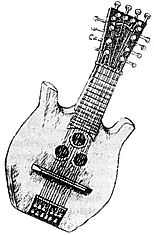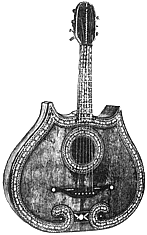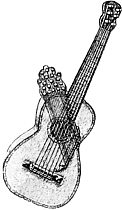| |
 |
Classical guitar page |
 |
| History of classical guitar |
|
The article author (Russian guitarist, singer, composer and educator)
|
  Guitar is the stringed instrument
played by plucking of the lute family. The word "guitar" is of Sanscrit
origin (from the word "cutur", what means "fourstringed"). Guitar is the stringed instrument
played by plucking of the lute family. The word "guitar" is of Sanscrit
origin (from the word "cutur", what means "fourstringed").
The history of its origin goes into the depths
of thousand years and leads its beginning from the human civilization
cradle-ancient east.
The first picture of a music instrument like
guitar was found by the archaeological excavations of Bel Temple in
Nuffar (Nipur) situated at the former territory of Shumero-Babylon.
On The clay bas-relief, concerned to the middle
of the third thousand years B.C., is pictured a herdsman sitting on
the stone and playing a music instrument.
Oblong-rounded body of the instrument and
a long finger-board permit to suppose that this is a kinnor, the guitar
prototype, often mentioned in biblical legends.
On the other picture, found by the excavations at the territory of
the former khettes New empire (XV-XIVth century B.C.), we see an instrument
having a body in the form of eight with some small voices an a long
finger-board with tune plates. It is supposed that the instrument
by khettes as by the shumers was named a kinnor. It is possible, that
the same instrument or like it by the other peoples of the Ancient
East was named cutur, gasur, nabla, makhal and so on.
The kinnor was known also in the Ancient
Egypt. By the one version, it came to the Egyptians approximately
in the XV-th century B.C. and was named nefer or nabla. By the other
version, this music instrument appeared in Egypt and Shumero-Babylon
at the same time. Its hieroglyphic picture can be seen on the Ancient
Egyptian pyramids. It is interesting to note that the same hieroglyph
signified "good", "fine", "beautifully".
By the excavations of Assyrian palace in the town Ninevia (VIII-VIIth
century B.C.) was found the bas-relief with the picture of ceremonial
divine service in the temple. On the bas-relief we see two dancers
in lion's mask and a musician with
an instrument like a guitar. The instrument body is of the oval form
with the length equal to the musician's forearm, with the finger-board
in four times exceeding the body length. This music instrument looks
line the Latin guitar (it will
be described below) and can be found in our days by the peoples of
Asia Minor at the name of tamboura.
The Babylonians of Navukhodonosor' days
(VII-VIth century B.C.) had an instrument named sabbec or sambuc with
four strings, salient body and a finger-board with tunes. It was adopted
by Ancient Greeks and Romans.
  Coming from Asia to Europe, the sambuc
changed its names (pectis, magadis), but at the end it was known as
Asian cuitar or cuitar (cuitarr). In the Athenian National museum
there is a sculptural picture of the performer at this instrument.
The picture is dated 400th year B.C. Coming from Asia to Europe, the sambuc
changed its names (pectis, magadis), but at the end it was known as
Asian cuitar or cuitar (cuitarr). In the Athenian National museum
there is a sculptural picture of the performer at this instrument.
The picture is dated 400th year B.C.
In the first thousand years A.D. in
European coutries of Mediterranea the Latin guitar was spread, musical
instrument, popular by the Ancient Romans, like cuitar. In the XIIth
century it was well-known in Europe, it had three and four strings
(in some versions there were more strings).
The flourishing of the Europe musical
culture in the Renaissance (XV-XVI cent.) was good also for the guitar
art. In the XVI-th century in Spain the guitar is a national instrument;
to the four strings the fifth is added and from this time the guitar
receives the Spain pith (E, H, G, D, A) at it were doubled and only
the first was single.
The
five-stringed guitar begins successfully to compete with the popular
in that time lute and vihuela, its nearest relatives. They appear
educational textbooks and literature collections (tablature - music
record spread before the XVIII-th century) where were printed Ancient
Spanish dances: chaconne, passacalia, sarabanda, folia and others,
and also Spanish songs and romances. It is seeked after the improvement
of instrument design and playing technique.
There are many famous virtuosos and composers-guitarists: G.
Sans (1640-1710); F. Corbett (1620-1681), served at the courts of
Spanish, French and English kings;
R. de Vise (1650-1725), court guitarist and luteist of the French
kind Ludovik the XIV; F. Kampion (1686-1748) and many others.
At the and of the XVIII-th century
the guitar looks like the modern appearance: the sixth string is added
(E), doulled strings are changedto single strings. From this time
the six-stringed guitar begins its triumphal procession through the
world countries.
 In the first half of the XIX-th century
in Europe begins "the golden century" of the guitar. So
well-known composers as F. Shubert, G. Berlios, K. M. Veber write
the music for it. In the first half of the XIX-th century
in Europe begins "the golden century" of the guitar. So
well-known composers as F. Shubert, G. Berlios, K. M. Veber write
the music for it.
The brilliant violinist N. Paganiny
was also the excellend guitarist. Many contemporaries thought that
with his unsurpassed skill he was obliged to the guitar because he
carried many technical methods from the guitar to the violin. Paganiny
composed for the guitar 140 solo pieces, 2 sonatas for the guitar
and violin, duets for the violin and guitar, trio and quartet for
bow instruments with the guitar.
In this time they appear many famous
virtuosos and composers who raised the playing skill at the guitar
to the unprecedented loftiness and made the foundation of the classic
musical literature for it. They are Spaniards F. Sor and D. Aguado,
Italians M. Giuliani, Carulli and M. Carcassi. |
|
|
|
History
of classical
guitar
|
|
|



